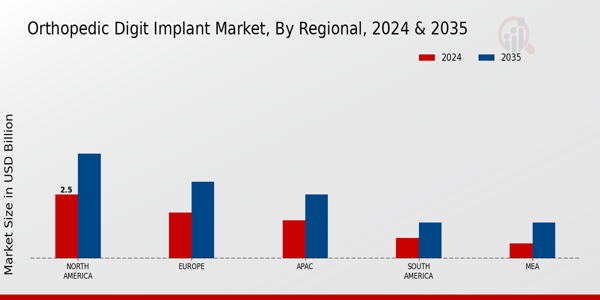Rising Geriatric Population
The rising geriatric population is a significant driver of the Orthopedic Digit Implant Market. As individuals age, they become more susceptible to degenerative diseases and injuries affecting the hands and fingers. The World Health Organization projects that the number of people aged 60 years and older will double by 2050, leading to an increased demand for orthopedic interventions. This demographic shift necessitates the development and availability of effective orthopedic digit implants to address age-related conditions such as osteoarthritis and fractures. Furthermore, older adults often seek surgical solutions to maintain their independence and quality of life, which further fuels the market. The growing recognition of the need for specialized orthopedic care for the elderly is likely to enhance the Orthopedic Digit Implant Market in the foreseeable future.
Enhanced Surgical Techniques
Enhanced surgical techniques are playing a pivotal role in the growth of the Orthopedic Digit Implant Market. Minimally invasive surgical approaches have gained popularity due to their associated benefits, including reduced recovery times and lower complication rates. These techniques allow for smaller incisions and less trauma to surrounding tissues, which is particularly advantageous in delicate areas such as the fingers. As surgeons become more skilled in these advanced methods, the adoption of orthopedic digit implants is expected to rise. Additionally, training programs and workshops focusing on these techniques are becoming more prevalent, further encouraging their implementation in clinical practice. The combination of improved surgical methods and the increasing availability of orthopedic digit implants is likely to drive market growth, as patients seek out less invasive options for treatment.
Increasing Incidence of Hand Injuries
The rising incidence of hand injuries, particularly among athletes and the elderly, is a notable driver for the Orthopedic Digit Implant Market. Statistics indicate that hand injuries account for a significant percentage of all musculoskeletal injuries, leading to a growing demand for orthopedic digit implants. As the population ages, the prevalence of conditions such as arthritis and fractures increases, necessitating surgical interventions. This trend is further exacerbated by the active lifestyles of younger demographics, who are more prone to sports-related injuries. Consequently, healthcare providers are increasingly adopting orthopedic digit implants as a viable solution to restore functionality and improve quality of life. The market is projected to expand as awareness of treatment options grows, with an estimated increase in procedures related to hand injuries expected to drive the Orthopedic Digit Implant Market in the coming years.
Technological Innovations in Implant Design
Technological innovations in implant design are transforming the Orthopedic Digit Implant Market. Advances in materials science and engineering have led to the development of more durable and biocompatible implants, which enhance patient outcomes. For instance, the introduction of 3D printing technology allows for customized implants tailored to individual patient anatomies, thereby improving fit and function. Additionally, the integration of smart technologies, such as sensors within implants, offers the potential for real-time monitoring of recovery and performance. These innovations not only improve surgical success rates but also reduce the likelihood of complications, which is crucial for patient satisfaction. As these technologies continue to evolve, they are expected to attract more healthcare providers to adopt orthopedic digit implants, thereby propelling the growth of the Orthopedic Digit Implant Market.
Growing Investment in Healthcare Infrastructure
Growing investment in healthcare infrastructure is a crucial driver for the Orthopedic Digit Implant Market. Governments and private entities are increasingly allocating resources to enhance healthcare facilities, particularly in developing regions. This investment is aimed at improving access to advanced medical technologies, including orthopedic digit implants. Enhanced infrastructure not only facilitates the availability of surgical procedures but also promotes the establishment of specialized orthopedic centers. As healthcare systems evolve, the demand for orthopedic digit implants is expected to rise, driven by improved patient access to surgical interventions. Furthermore, the establishment of training programs for healthcare professionals in these regions is likely to enhance the quality of care provided, thereby fostering growth in the Orthopedic Digit Implant Market.


















Leave a Comment